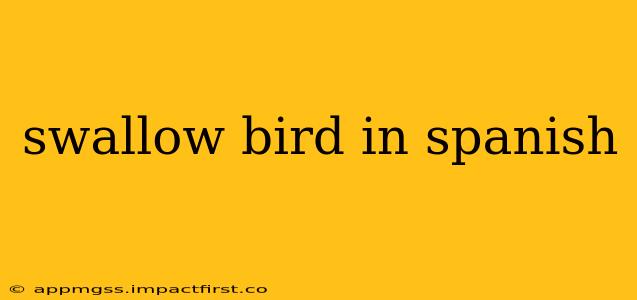Swallow Bird in Spanish: More Than Just One Word
The simple answer to "swallow bird in Spanish" is golondrina. However, the beauty of language lies in its nuances, and understanding the context and regional variations adds depth to this seemingly simple translation. This post will explore the different ways to refer to swallow birds in Spanish, helping you choose the most accurate and appropriate term for your needs.
What are the different types of swallows? (People Also Ask - Google)
This question highlights the importance of considering the specific swallow species. While golondrina is a common and widely understood term, it's a broad term encompassing many different species of swallows. There isn't a single, universally accepted Spanish name for each individual swallow species, just as there isn't in English. The specific names often vary by region and depend on local colloquialisms. To know the precise name for a specific type of swallow, you'd need to specify the species (e.g., Barn Swallow, Cliff Swallow, etc.) and then research the regional Spanish name.
Is "golondrina" the only word for swallow in Spanish? (People Also Ask - Bing)
While golondrina is the most common and widely understood term, regional variations exist. Depending on the region, you might encounter other words, though these are often less common than golondrina. These variations often arise from the specific dialect or even local nicknames for the birds. Unfortunately, there isn't a comprehensive list of all regional variations, as they're often informal and not documented in standard dictionaries.
What's the difference between golondrina and other similar words? (Implied PAA)
The primary difference lies in usage and region. Golondrina is the dominant and generally accepted term across most Spanish-speaking countries. Other potential words (which, again, vary regionally) might be used in specific dialects or even be related to a specific type of swallow prevalent in that area. This makes golondrina the safest and most effective choice for general use.
How do I say "swallow bird" in different Spanish dialects? (Implied PAA)
As mentioned, dialectal variations exist, but pinpointing these variations requires knowing the specific dialect and region. For instance, in certain parts of Spain or Latin America, a more localized word or a slightly different pronunciation of golondrina might be used. To understand the exact nuances within a specific region, you'd need to research the local dialects and colloquialisms.
Beyond the word: Understanding the cultural significance (Added Value)
The swallow bird holds cultural significance in many Spanish-speaking communities. They are often associated with spring, hope, and good fortune. In literature and folklore, swallows frequently feature as symbols of return, migration, and the cyclical nature of life. Understanding this cultural context enriches the understanding of the word golondrina beyond its simple translation.
In conclusion, while golondrina is the most accurate and widely understood translation of "swallow bird" in Spanish, it's vital to remember the regional and contextual variations. The best approach is to use golondrina unless you have specific regional information requiring a different term. Always consider the cultural context to fully appreciate the meaning and significance of this common bird across the diverse Spanish-speaking world.
